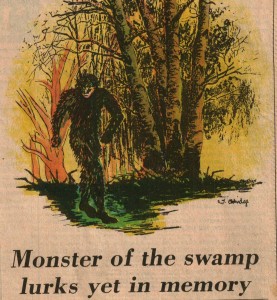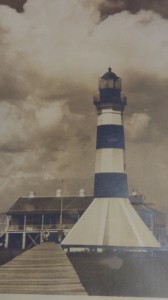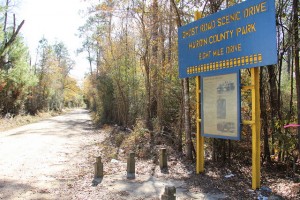Some SETX history is permanently engraved in our minds, such as the discovery of oil at Spindletop and the Battle of Sabine Pass where Richard (Dick) Dowling and his band of 45 fellow Irishman overcame all odds and defeated a 5,000-strong Union flotilla. I would also put Arthur Stilwell’s “Dream City” down as another historic event that is regularly recognized, even though not too many people will know the whole story. It is nevertheless interesting to look back at the origins of Stilwell’s “hunch.” So let us examine Arthur’s role in SETX history.
Born in Rochester, New York, to Charles and Mary Stilwell, Arthur Edward was by some accounts a “sickly child,” although this is not mentioned frequently in respectable sources. Indeed, there is not much mention at all of his early childhood in any of the sources I’ve found—at least not until his 14th year. Only later, in his own writings, would Stilwell mention certain aspects of his early life. And in those writings we find a treasure trove of just who Arthur was and what would steer him on the path to prosperity.
“All my life, even when a child, I have received messages from the spirit world and they have greatly influenced my life,” he wrote in his book Live and Grow Young (1921). Arthur Stilwell was a Spiritualist and believed that he had contact with the spirit realm. Based on his English heritage, the Brownies, as he called them, were influential in his business dealings. These “nightly visitors” even foretold his marriage to Jennie Wood:
When I was 15 years of age my life’s companion was selected for me by this choir invisible, and I was told that I would marry her when I was 19 years old, which I did. The wisdom of their selection and my appreciation of it has been the paramount factor in strengthening my faith in these leadings.
Jennie and Arthur were married on June 10, 1879 in Iona, Virginia. That same year they moved to Kansas City where Arthur took a job at a friend’s print shop. After he had recovered from a bout of typhoid fever, they left Kansas City and moved to Chicago. During this time he began a new career selling insurance for the Travelers Insurance Company, a venture that proved to be very profitable. So profitable in fact that Arthur invented a new policy called a Coupon Annuity Endowment. This was the first type of life insurance policy that gave the holder a monthly income after they reached a certain age.
In 1886 the Stilwell’s moved back to Kansas City where Arthur founded the Real Estate Trust Company, but in 1889 the real estate market took a hit. Fortunately, all was not lost. In another endeavor, Arthur formed the Kansas City Terminal Construction Company after winning a contract with the Kansas City Suburban Belt Railway. And so went his entrance into the railway industry.
In the early 1890s Stilwell began forming, building, and acquiring other rail lines in an attempt to follow through with his nightly visitors’ plans of extending a railroad to the Gulf of Mexico.
From the plan and advice received in this way I have been able to build five western railroads, 2,500 miles all together- more than any other living man has constructed. By this means I have founded forty odd cities and villages with a combined population of 125,000. I was warned by my nightly advisers not to make Galveston the terminal of the Kansas City Southern Road because that city was destined to be destroyed by a tidal wave, which prediction was fulfilled, tragically, four years later. Thereupon, I constructed the City of Port Arthur, Texas, and built the Port Arthur Ship Canal and Harbor under the same guidance, not deviating from the plans revealed to me in any way.
Arthur’s nightly advisers were certainly “accurate” according to all the writings I have seen, but one must take into account that they were all written after the fact. So take that into consideration the next time a voice in the night tells you to construct a railroad.
Interestingly, an article dated August 2014 by Judith Linsley gives a different story about how Arthur Stilwell came to build Port Arthur. Two daughters of Mark Wiess were interviewed in a Port Arthur News article on Independence Day 1948, and both Octavia Wiess Andrus and Olga May Wiess Hoopes stated that their father was the one who had pointed out just where to build the city.
Mark Wiess’ part in choosing the Port Arthur townsite was also quoted in his obituary, which appeared in the July 2, 1910 Beaumont Journal. When Stilwell was considering Sabine Pass as a terminus for his new railroad, the landowners wanted too much for the right-of-way. At that time, Wiess suggested that Stilwell buy land nearby, owned by W.P.H. McFaddin, W.W. Kyle, Sr., and his brother Valentine, partners in the Beaumont Pasture Company. Stilwell did so, and the rest, as they say, is history.
Whether it was Mark Wiess or the Brownies who pinpointed the ultimate settlement, there were certainly more players in the founding and development of Port Arthur. One of these developers was John “Bet-a-Million” Gates who, in 1899, took over the Kansas City, Pittsburg, and Gulf Railroad after forcing it into bankruptcy. He then named the company the Kansas City and Southern Railroad, which we still know today.
Now that Arthur Stilwell had been ousted from his post atop the railroad company, he moved back to Kansas City in search of other ventures. It wasn’t long before he announced plans to build another railroad but this time connecting Kansas City to the Pacific Ocean. Unfortunately this too went bust, and investors lost millions. Where were his nightly visitors? This is not known for sure, but ultimately, Arthur took a hiatus from the railroad business.
Stilwell would go on to write books, plays, and poems, all credited to his advisers. I have copies of most of his books, and they are interesting to say the least. In the one that I’ve quoted from, Live and Grow Young, Arthur explains life’s problems as well as illness and death. He further reveals the secret of longevity, but unfortunately he would die of apoplexy just seven years later, on September 26, 1928.
An additional dismal event to conclude this story features Jennie, his wife of 49 years. Thirteen days after Arthur’s death, Jennie Ann Wood Stilwell walked/jumped out of an eight-story New York hotel window. This article in the New York Times dated October 10, 1928 fills in the details:
Mrs. Arthur Edward Stilwell, widow of the railroad builder who died just two weeks ago, ended her life yesterday morning by jumping from a twelfth floor window of her apartment at 305 West End Avenue. Notes addressed to her brother-in-law and sister-in-law, Mr. and Mrs. Burton W. Robb of Buffalo, said the death of her husband left nothing in life for her and requested that they dispose of her property.
Mrs. Stilwell was to have gone to Buffalo last night to make her home with the Robbs in accordance with their plans. The tickets had been bought.
Because of her despondency since the death of her husband her relatives had been apprehensive that she might attempt to end her life. Consequently when Mr. Robb noticed a light burning in her room at 5:45 A.M. he looked through the door to assure himself that all was well. He found the bed empty and a window raised. A glance out confirmed his fears. Mrs. Stilwell’s body was on the roof of a four-story building at 303 West Seventy-fourth Street.
A note, evidently prepared the night before, announced her intention to end her life. She said life was empty without her “darling,” as she referred to her husband.
Mr. Stilwell had been retired from active business for eight years before his death. He and his wife had withdrawn from their friends. During his later years Mr. Stilwell was much interested in spiritualism, an interest which his wife did not share, according to relatives.
Mrs. Stilwell, who was Miss Jennie Wood, was born in Rochester in 1860. She was married to Mr. Stilwell in 1879. A sister, Mrs. Mary Ferris of Binghamton, survives.
In accordance with her wish, no funeral services will be held. Her body will be cremated as was her husband’s.
Did the Brownies guide Arthur to prosperity here in SETX? I have no clue, but what I do know is that this is the second draft of this story. The first draft disappeared from my computer without a trace. Strange but true. One thing I have learned from this whole episode is to NEVER EVER compare an English faerie to a Scottish brownie.





You must be logged in to post a comment.